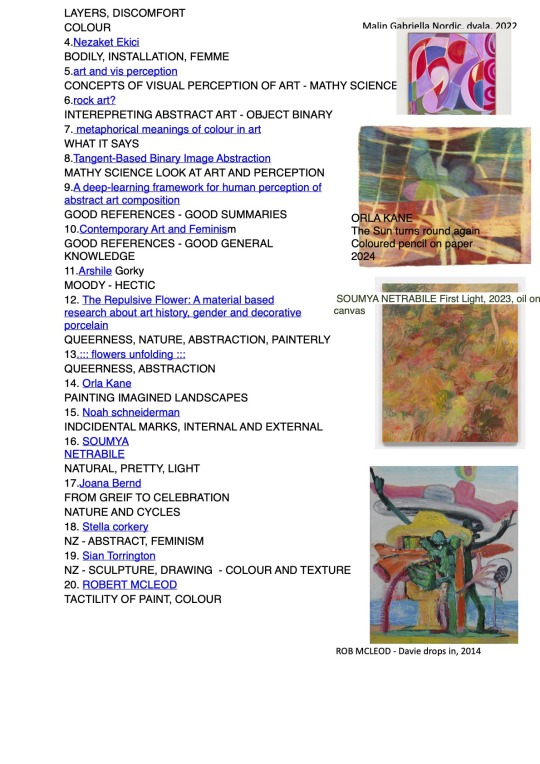Text
FORMATIVE Crit Notes

Blind crit
Colour palette - strong colours
Neons - work well, not jarring
Different things allother on wall (2 stretched works vs unstretched, different vibes on wall) make it hard to draw and reconsile conclusions
Eclectic group of works
Restrained underpainting vs grid over top - contains and obscures undrneath. Connects the layers
Looping
Grid reminds of tweed and tartan
textural
Sense of time put into work - obvious labour and working back in
Symbolic shapes and patterns?
Is it a self portrait - the connections with my hair
Apparently exploritory
Can see a sense of intention
Test works in a space away from the studio location - clean walls? Something similar to tying it up from last year Unstretched one - reinstall in fun ways
Ghosts of past work on walls
Frames? Physical or painted
A frame that is a painting? Around another work
Learn to stretch canvas
0 notes
Text
Formative Hand in
Showing in situ, not worried about cleaning up around as I like to share parts of the process that might not usually get to be seen!
dreamy, colourful
showing my palette as well because it is essentially its own work of art

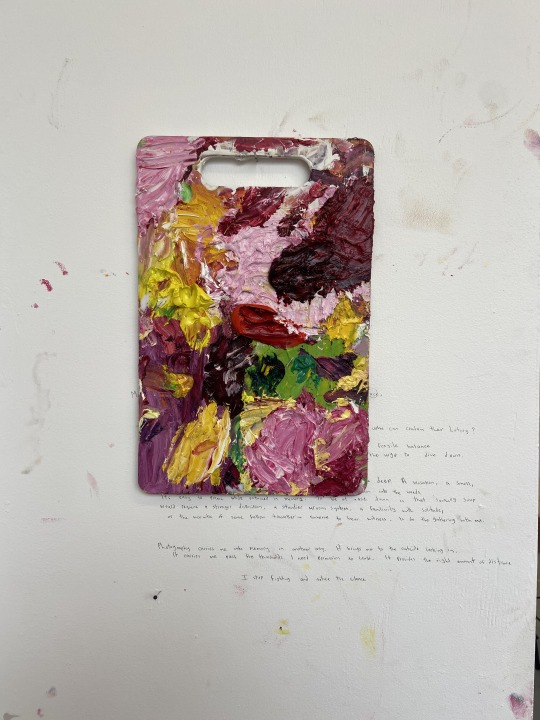
0 notes
Text
showing a hidden truth
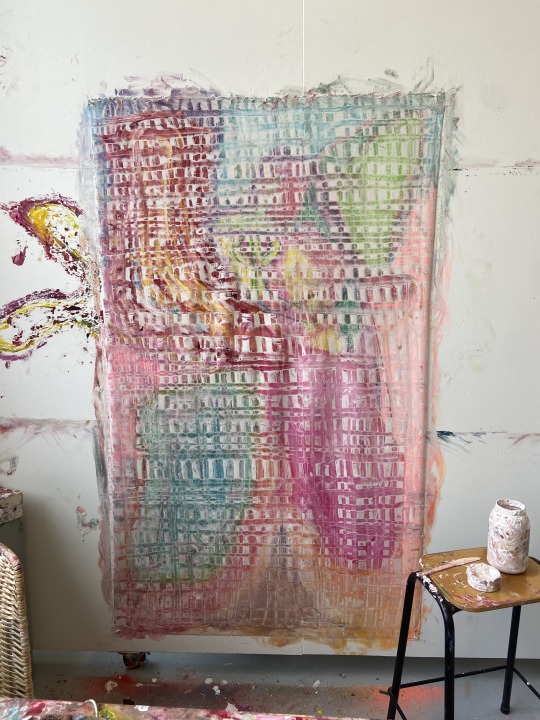
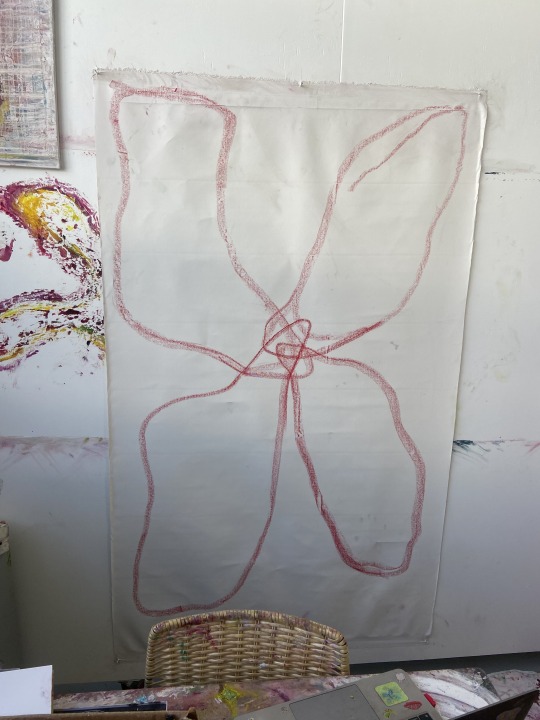
I didnt do a very good job of documenting the process of making this one as it all happened in about an hour or so....
Like my last work essentially but on a much bigger scale. this is going to be the main focus of my formative I reckon. a good launching point for the rest of the semester. I can try different ways to scratch back, different shapes and tools to hide and show what I would like, or what happens to be shown in the process.... maybe think more about a super detailed background for there to be more to be made out from underneath? something to get in lost while staring at.
0 notes
Text
An Exploration of How Objectivity Is Practiced in Art - Siun Hanrahan
ANALYSIS OF THE ARTMAKING PROCESS
The art-making process begins with an initial idea or set of ideas, comparable to Monroe Beardsley's "incept" [20]. Something-be it verbal, visual, aural or whatever-strikes a chord or claims attention, although what is important about it need not be particularly clear.
https://www-jstor-org.ezproxy.massey.ac.nz/stable/24434910
https://philpapers-org.ezproxy.massey.ac.nz/rec/BEATAP-2
"restrainer/restrained" was the initial idea from which the art-making process proceeded; in the second series of sculptures the initial idea was an experience of movement.
"we can know more than we can tell"-a sense that exploring the thing/idea that strikes a chord will prove fruitful [21].
https://www-taylorfrancis-com.ezproxy.massey.ac.nz/chapters/edit/10.4324/9780080509822-7/tacit-dimension-michael-polanyi
once a set of ideas has been mapped onto a set of physical relations, adjusting the relations between the physical parts effects adjustments within the set of ideas.
In playing with the physical relations one can assign priority to either the materials' potential or the forms being generated.
An important part of the art-making process is standing back and considering what has been made. Such consideration generally focuses on three things:
1. The ways in which what has been made succeeds in manifesting its intended concerns.
2. The ways in which what has been made fails in manifesting its intended concerns.
3. What is evident in the work apart from its intended concerns? When a work is thus challenged, other points of view are anticipated.
Different viewers ask different questions of or bring different interests to bear upon, the work, and one's perception of the work may be re-structured by engaging in or adopting alternative points of view in relation to it.
what criticism or exposure to an alternative point of view does is draw one's attention to certain features so that from that point forward one sees those features [25].
https://books-google-co-nz.ezproxy.massey.ac.nz/books?hl=en&lr=&id=LiwgjNiHkm4C&oi=fnd&pg=PP11&dq=Ludwig+Wittgenstein,+Wittgenstein%27s+Lectures,+Cambridge&ots=DwT-5qybsL&sig=SItDbDfutpCxs7BSdWUXP4sb42U&redir_esc=y#v=onepage&q=Ludwig%20Wittgenstein%2C%20Wittgenstein's%20Lectures%2C%20Cambridge&f=false
This aspect of the making process is the most "objective." The first two questions above explore whether the intended dynamic is actually manifest in the work; can others see what the artist sees. The third question explores the resonance of the work (of its materials, technique and form) from points of view other than one's own.
t there is more and less in the "made thing" than was anticipated-that is, the work frequently exceeds expectations in some respects and falls short of expectations in other respects.
The key to this inter-subjective exposure is to determine whether or not the intended reading survives despite the effect of different perspectives and, following from this, what needs to be done to achieve or amplify this.
Difficulties identified in the work may be either "logical" or visual [26]. Logical flaws are ones in which the material interaction fails to exemplify the idea behind it. There is a breakdown in the manifestation of the idea. Visual flaws are ones in which the material interaction is not visually acceptable or satisfying
As used here "logical" applies to the step-by-step process through which "the conception" of a work is generated in the material interaction. Consequently its true equivalent is not the visual but the step-by-step process by which the visual is generated by the material interaction. Using these particular alternatives thus reveals a bias in my art practice. I prioritize the conception and so where there is a visual breakdown I search for a more elegant arrangement of the conceptual logic rather than the visual logic. Nonetheless, I would argue that this does not devalue the visual, as it is this that drives my refinement of the conception.
the logical and the visual are generally symbiotic; when a flaw is identified in the one, it can usually be resolved by re-thinking the other.
. Deciding which considerations are brought forward through further making generally involves both objective and subjective inflections of thought
A concern for inter-subjective judgment, or "objectivity," is reflected in modifications aimed at amplifying the intended reading of the work, given the effect of the different perspectives encountered.
A concern for "subjectivity" is reflected in modifications that are interesting but peripheral to the intended reading of the work.
Eventually, the making-considerationmaking dynamic must be brought to a halt and a decision taken to the effect that a "made thing" can stand on its own as an artwork
The making process must stop at some "made thing" which we decide to accept. If we do not come to any decision, and do not accept some "made thing" or other, then the "making process" will have led nowhere. But considered from a logical point of view, the situation is never such that it compels us to stop at this particular "made thing" rather than that, or else give up the "making process" altogether .... Thus if the "making process" is to lead us anywhere, nothing remains but to stop at some point or other and say that we are satisfied for the time being [28].
https://www-taylorfrancis-com.ezproxy.massey.ac.nz/books/mono/10.4324/9780203994627/logic-scientific-discovery-karl-popper-karl-popper
This decision, to let a "made thing" stand as an "artwork," is taken (1) if the "made thing" succeeds in manifesting its intended concerns, (2) if it has not been shown to fail in relation to its intended concerns, and (3) if what is evident in the "made thing" apart from its intended concerns does not inhibit or overwhelm them.
intuitive art-making
scientific investigation places greater emphasis upon the critical examination of proposed orders, while artistic investigation places greater emphasis upon conceiving alternative orders.
the relationship between art and science is not a matter of boundaries but of intertwined inflections of understanding. The order that science brings to our understanding of the world is complemented by art's exhibition of our ultimate responsibility for ordering the world.
0 notes
Text


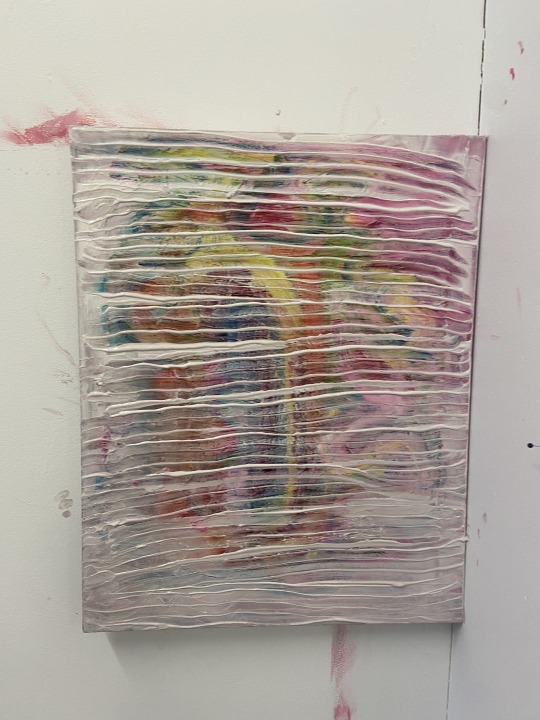


DID i just.... do something?
painting, gesso, scratch back the gesso, soft pastels, gesso, scratch, define, done!
thinking about obscuring the image. which allows for the work to exist beyond its original purpose. to hide and expose in one motion. colours blend or simply just meet. simple shapes have a mystique underneath repetitional acts of distortion.
0 notes
Text
STELLA CORKERY

Stella Corkery, Threads, 2021, oil and gesso on canvas, 400 x 300mm
Redefining the previous critical lives of painting and ideas surrounding feminism act as drivers for Stella Corkery’s practice. References within her work can stretch across art history, contemporary art, popular culture and musical influences such as post-punk and improvised sound. The result is bodies of work that often appear to belong to disparate systems, yet still operate within a conceptually unified program. Experimental musical projects including solo work and as part of the duo White Saucer maintain a direct line to her visual practice.
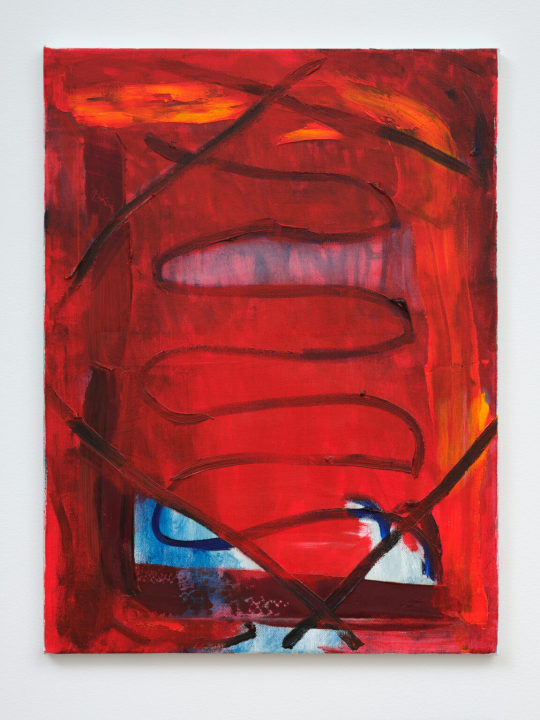
Stella Corkery, Hot Wire, 2021, oil on canvas, 605 x 455mm
0 notes
Text
directional pull




started out in frustration, but here I allowed myself to just feel and not worry about an outcome. of course, this means that I actually enjoy the outcome for the first time in some time with my works
oil paint and soft pastels on canvas!
I've been thinking about how my thoughts influence the works but how no one will see it how I do! i love that idea and all the great artists and readings I've been seeing have been helping my development of a solid idea to stand on.
0 notes
Text
The Binary Economy of Art
An Exploration of How Objectivity Is Practiced in Art Author(s): Siún Hanrahan
Source: Leonardo, Vol. 33, No. 4 (2000), pp. 267-274 Published by: The MIT Press
Stable URL: http://www.jstor.org/stable/1576900 .
Art lack of objectivity
Harold Osborne:
As the scientist creates ordered conceptual systems, working for the extension of understanding and incidentally for the greater powers of control over the environment which understanding can bestow, the artist creates perceptible constructs, each with its own perceptible beauty, working for the enhancement of percipience, the enrichment of perceptual experience, and adding to the cultural heritage of mankind
Binary thinking
science begins when "artistic license" is cancelled, and art begins when the cold objectivity was set aside.
“ This description is no longer compelling, and yet the assumptions on which it is founded persist.”
"restrainer/restrained" to allude to an individual's responsibility for meaning
Exploration of the concepts of this dynamic through found materils like coal and wire. Using, weaving and building techniques to exemplify the idea of the restrainer and the restrained
the interdependence of expectation and perception and thus our ultimate responsibility for the meanings ascribed to, and in, the world.
“One's initial idea or set of ideas is visualized or made manifest through physical or concrete sets of relations. Such concrete anchoring allows relations within a set of ideas to be modelled and re-modelled and allows their consequences to be explored. In other words, once a set of ideas has been mapped onto a set of physical relations, adjusting the relations between the physical parts affects adjustments within the set of ideas. In the sculpture 3-Way Combination, for example, the different techniques used (weaving, building, trapping, etc.) and the different combinations of materials (in the three parts of the sculpture) affected different constructions of, and emphases within, the concept of "restrainer/ restrained." “
refinement of the initial idea is achieved through attending to, and playing with, relations within and between objects
Responsibility - series one
"restrainer/restrained."
individual's responsibility for meaning

Fig. 1. 3-Way Combination, installation of coal, copper wire and upholstery springs, 65 cm high x 170 cm wide x 105 cm deep, 1994. (? Siun Hanrahan) This sculpture poses and provides one answer to questions relating to the potential instantiation of "restrainer/ restrained" dynamics within a given set of materials.
3-Way Combination explores the potential of "restrainer/restrained" dynamics within a particular set of materials
each material, in turn, engages with a combination of the other two so that each material presents both restrainer and restrained in a single interaction. sculpture offers three instances of "restrainer/restrained
works explored the interdependence of expectation and perception and thus our ultimate responsibility for the meanings ascribed to, and in, the world.
readings arose about the sculptures-readings concerned with movement, tensegrity structures in engineering, social issues to do with labour and gender, sociological/anthropological symbolism and zoological/topographic morphism ment and the impression of internal tensions and stresses.
Translating Movement - series 2
a "story" that tells of the growth of a negative space
the fourth artwork in the series (Scale) presents a cryptic version of translations of the story of a negative equilateral triangle's growth
This excess of detail signals that communicating the "story" is not the primary objective of the work. To paraphrase Rosalind Krauss, such repetition breaks down the principle of spatiotemporal uniqueness that is a prerequisite of logical narration; it destroys the very possibility of a logical narrative sequence 16
https://books-google-co-nz.ezproxy.massey.ac.nz/books?hl=en&lr=&id=Z7pRNZaC4YAC&oi=fnd&pg=PA1&dq=.+Rosalind+Krauss,+Passages+in+Modern+Sculpture&ots=iVv5SBsJRo&sig=IsjDm0OKFDYWa9LJ6TqVTxjv3Lo&redir_esc=y#v=onepage&q=.%20Rosalind%20Krauss%2C%20Passages%20in%20Modern%20Sculpture&f=false

Fig. 3. Scale, sculptural coal installation, 27.5 cm high x 275 cm wide x 238 cm deep, 1995. (? Siun Hanrahan) Scale tells of the growth of a negative equilateral triangle from 40 cm to 275 cm but without elaboration-only one negative triangle is actually presented, measuring 275 cm, while the previous stages in its growth are evident in the lines intersecting (and thus marking) one edge of the 275-cm triangle.
the "story" of the growth of a negative equilateral triangle is not easily legible in the artworks that it generated and although the story can be "made out," other readings are more readily apparent in the work
David Smith has said, "The name [or, in this case, the story] is an affectionate designation of the point prior to travel" [17].
https://www-tandfonline-com.ezproxy.massey.ac.nz/doi/pdf/10.1080/00043249.1970.10794706 p71
while the story of the negative triangle may be all but lost in being over-told, its point-virtual movement-is not.
; a clue to the unfolding of a story may be gleaned by the direction of increase, or of decrease, in the size of the coals. At this point, however, the viewer receives no more clues.
For what we find is the "system" of compulsion, of the obsessional's unwavering ritual, with its precision, its neatness, its finicky exactitude, covering over an abyss of irrationality.... The obsessional's solutions to problems strike us as mad, not because the solutions are wrong, but because in the setting of the problem itself there is a strange short-circuit in the lines of necessity [18].
https://books-google-co-nz.ezproxy.massey.ac.nz/books?hl=en&lr=&id=D5-C2w8n5NwC&oi=fnd&pg=PP11&dq=Rosalind+Krauss,+The+Originality+of+the+AvantGarde+and+Other+Modernist+Myths+&ots=6LaV1RINKD&sig=X6ly40Xuxnq1l4ZovTUUlMqdevk&redir_esc=y#v=onepage&q=Rosalind%20Krauss%2C%20The%20Originality%20of%20the%20AvantGarde%20and%20Other%20Modernist%20Myths&f=false
The juxtaposition of arbitrariness and reason forms a certain irony. By rigorously applying reason in relation to its arbitrary premises, this system posits reason and order as necessary but not absolutely valid
The obsessive purposefulness of the placement of the coals has another significant impact upon the viewer. The possibility of easily dislodging such carefully placed but unfixed coals tends to make viewers intensely aware of their feet, lest some coals be disturbed in a careless moment.
Such discomfort serves the purposes of the work quite well, in that attention is drawn not only to the potential movement exemplified by the coals but also to the viewer's own movements.
"Art is not didactic. It is not final. It is always waiting for projection by the viewer" [ 19].
https://www-tandfonline-com.ezproxy.massey.ac.nz/doi/pdf/10.1080/00043249.1970.10794706 p137
0 notes
Text
Sian Torrington

To be, to carry Paint, wood, canvas, fabric, wool, thread, glitter. Wooden structure by Luca Larkin
"Sometimes art making feels like an act of self-acceptance. What are these tangled, drippy, complex, funny things? They are you, and me, and what’s between us. They push and pull, unravel and stick together. They are proud and stand up. They are tired, and slump against a wall, their back drooping and moulding to what’s already there."
"I create visible, physical structures through drawing and sculpture, that reflect the beings we are. In woven together pieces of ribbon, fabric and paint, we see moments of discovering support, reaching out, fragility and courage. Process-based drawings and collages in pastels, charcoal and pencil are made without a plan, building one colour up to make friends with another. Shapes and forms are organic, diverse. The viewer is invited on a visual adventure, traversing slides, curves, swooshes and sticky bits. Where is the beginning and where is the end? Everything is connected, and you are welcomed into this permissive space where you are allowed to make your own connections. It is about feeling."
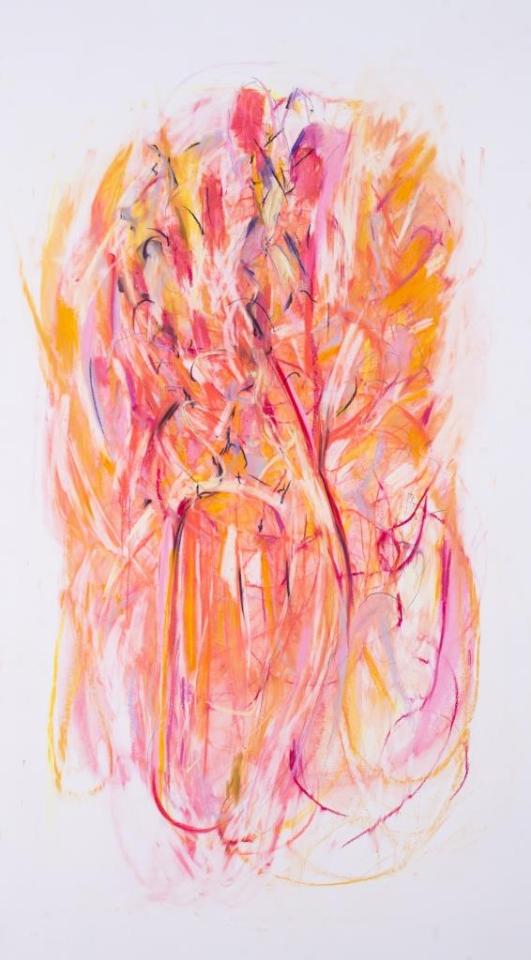
Way in
Pastel and pencil on paper, 1500mm x 900mm, framed
0 notes
Text
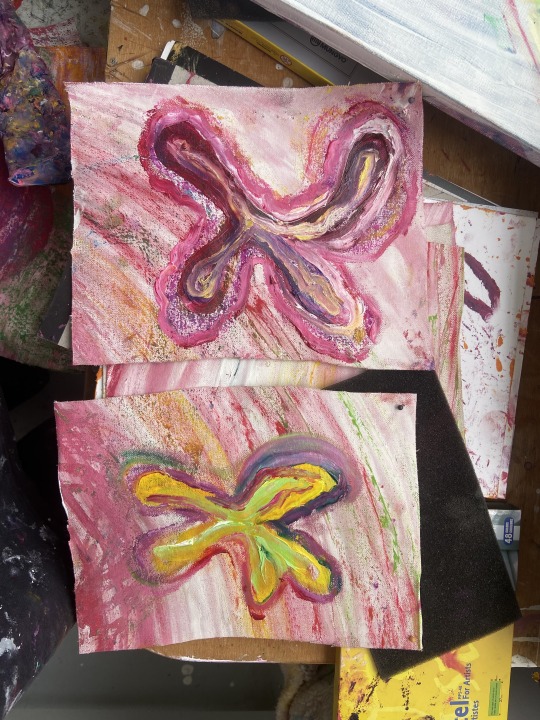


shapes on the small cut-up canvas
might scrap, might come back... bit lacklustre atm
done lots of reading and thinking but right now it's not properly translating how I want it to!!!
0 notes
Text
Millner, Jacqueline, and Catriona Moore. Contemporary Art and Feminism.
Conclusion pg 238
The seemingly simple question—how can feminism translate into a socialmovement today?—is a wake-up call for feminists working in the academy and theartworld to keep reaching beyond these contexts to re-develop a grass roots politicsof alliance. An interesting recent turn is feminist artists extending their practice intothe formal sphere of political institutions, seeking and securing seats in local legis-latures by campaigning on their expertiseasartists, highlighting how artists haveparticular insights into community issues and the capacity for creative solutions.
feminist art as an activistpolitics of alliance, with three main strategic emphases, namely, decolonisation; re-imagining the art/life divide, and problematising‘equality’politics.
Ethnicity won’t join a white feminist agenda. It will transform it. It willbecome the central agenda of feminism, as rightly it should, because we arethe majority...the groundwork laid by white feminists of the 1970s, that bodyof knowledge, will be a resource, but we will have to redefine it according to238Conclusion
the experience of women of colour...I can’t relate to the universality of allwomen. We make these bridges tentatively, we don’t make assumptions, webuild a relationship slowly...It’s a long struggle, a long time buildingbridges
https://www-jstor-org.ezproxy.massey.ac.nz/stable/1358556
In reconsidering the historical disjunct between the studio and the street,
feminism dovetails with, and draws upon, centuries of de-colonial cultural resis-
tance by linking the artworld to other social spaces through a porous art practice
Artists registered excessive (including failed or under-performing) gendered sub-jectivities and sexual proclivities that complicated the representational demand to bemiddle class, white, straight and good looking. White feminists also learnt from FirstNations’perspectives that proposed a decolonising non-essentialism as a starting pointfor resistant acts of sovereignty, rather than investigating the politics of media/high artrepresentation as a (postmodern) end in itself. Feminist artists broadened their sightsbeyond the circularity of representational politics, towards a politics of acts rather thanof identities.
Across these diverse spaces, we noted how
feminist pedagogy has always been provisional, just as concepts of feminist aes-
thetics have never settled
Renewed attention to the materiality of feminist arts and crafting from the 1990salso helped to sideline the linguistic models that underpinned psychoanalytic ana-lyses of gender and sexual identities. Material practices could directly link to gen-erative and generous acts of non-essentialised common cause and care.
We argued that feminism contributes new artistic perspectives on art and envir-onment by confronting the lingering and gendered view within Western thoughtof nature as feminine and/or racially other.
These challenges have further transformedthe anthropocentric terms whereby Western landscape traditions read the land toexpress self-realisation through divine or proprietorial connection, to help build aneducative, ecological ethics.We noted how feminist participatory actions often have a community base devel-oped through listening to other voices and opening up overlooked spaces of cultural agency
The idea that personal life has political implications (and vice versa) lies at the heartof feminism and of this book. Consciousness raising methods derived fromWomen’s Liberation, such as supportive group reflection on the political implica-tions of women’s personal experience, found their way into feminist aesthetics asan interrogative tool and a means to assert, diffuse and multiply agency. It’s time toacknowledge how feminism introduced this expandedfield of the everyday, thedomestic and the collective into the artworld
it has now become an aestheticnorm in global exhibitions of contemporary art, with artists creating‘diurnal’pro-jects responding to local problems, working with local art co-ops, unexpected sites,
walks and mapping to engage memory and place
This book has tried to under-stand the varied ways that‘the personal is political’has shifted both the way we doart and the way we do politics. This slogan is still relevant today, in promptingintersectional reflection on how experiences of gender are also articulated by race,class, sexuality, disability, religion and geography
the traditional political creed of‘human solidarity’.
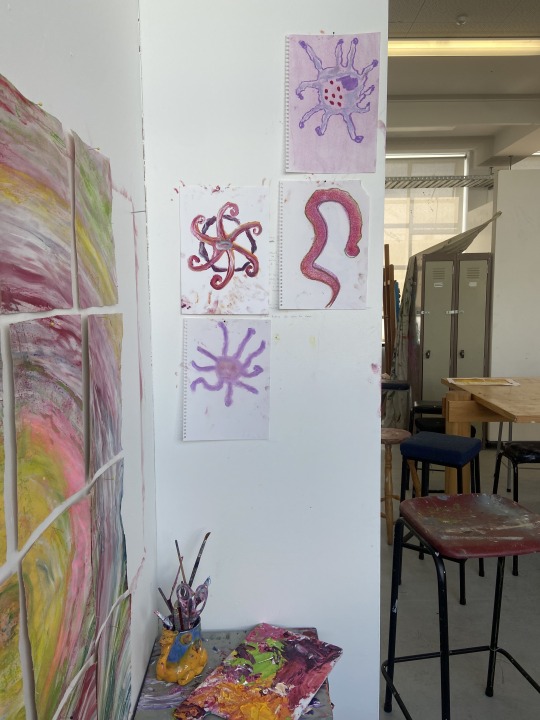

0 notes
Text
Millner, Jacqueline, and Catriona Moore. Contemporary Art and Feminism.
Pg 204
Feminist worlds
Jean luc
In attempting to grapple with how to respond politically to the death drive of neo-liberal global capitalism, French philosopher Jean-Luc Nancy urges us to,‘ask anewwhat the world wants of us, and what we want of it, everywhere, in all senses, all overthe world and for the whole world, without (the) capital of the world but with therichness of the world’.1He elaborates:
if the world, essentially, is not the representation of a universe...nor that of a herebelow, but the excess–beyond any representation of anethosor of ahabitus–of astance by which the world stands by itself, configures itself, and exposes itself initself, relates to itself without referring to any given principleor to any determinedend, then one must address the principle of such an absence of principle directly
This demands not that we signify the world, or assign it a proper sense, but that weinvolve ourselves completely with the world:‘it is the extremely concrete and deter-mined task—a task that can only be a struggle—of posing the following question toeach gesture, each conduct, eachhabitusand eachethos: How do you engage theworld?’3Nancy calls on us to‘make worlds’, non-totalising and immanent, throughour everyday being in the world
To underline the importance of aesthetics to politics, Rancière famously said that the real must be fictionalised in order to be thought. https://selforganizedseminar.files.wordpress.com/2012/10/rancic3a8re-jacques-politics-aesthetics-distribution-sensible-new-scan.pdf
Jacques Rancière’s views about the role of aesthetics.Rancière maintains that artworks help shape the social world, that‘the way we createart is intimately bound up with fundamental forms of intelligibility, with material signsand images which describe ways of being, seeing and doing. Art, then, plays a key rolein articulating the distribution of the sensible which governs any given social order
Feminist critiques have also had in their sights the co-option ofthe public by the state, including the use of art—such as more traditionally under-stood‘public art’—for the purpose of aligning the neoliberal agendas of commerceand politics, at times imposing a singular purported‘common good’withoutacknowledging, let alone promoting, counter views
Feminist art practices re-imagining the public have focused on forming and
connecting to disparate and often yet-to-be imagined communities
aspiring to remain open and incomplete;
they attempt to replace official processes and procedures with interpersonal unpre-dictability and risk underpinned by the trust and deep listening that underlines care;
they re-inhabit places and spaces to interrogate embedded narratives and amplify
previously silenced voices
Their collective work entreats feminists to go beyond personal levels of com-fort and move into spaces full of trepidation so as not to let rallying cries era-dicate difference and to listen to the silence that is protest...Without this movement toward uneasiness, toward awkwardness, toward discomfort, fem-inists may contribute to normalizing economic and social injustices as women across difference continue to be subjects and objects of systemic discrimination,economic exploitation, powerlessness, systematic marginalization and stateviolence...we must be open to possibility
https://www-tandfonline-com.ezproxy.massey.ac.nz/doi/full/10.1080/0966369X.2017.1351509


0 notes
Text
ORLA KANE
Orla Kane (B. 1999) is a Scottish artist based in Glasgow. Her practice currently concerns the imagined landscape through the expanded field of painting.

Storm catcher
Coloured pencil and crayon on paper
29.5 x 19.5cm
2024
super beautiful use of layering and colour
choices made to leave sections more untouched - creates shape in a whimsical way

Flowers Turning
Coloured pencil on paper
20.5 x 20cm
2024
directional - visual aspects of the medium, which is leant into rather than fought against
0 notes
Text

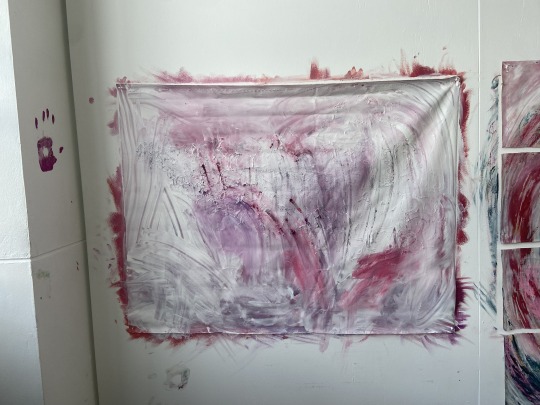
Change it up?
not sure atm what exactly im doing but I'm doing things so that's the main point.....
0 notes
Text
Millner, Jacqueline, and Catriona Moore. Contemporary Art and Feminism. Google Books, Routledge, 5 July 2021,
books.google.co.nz/books?hl=en&lr=&id=_h0vEAAAQBAJ&oi=fnd&pg=PT6&dq=feminism+abstract+painting&ots=4uLU1ewri9&sig=-GlB0vni50kWscSKQx2DWZe1bik&redir_esc=y#v=onepage&q&f=false . Accessed 16 Mar. 2024.
A rounded history of the deep connections between female/femme abstract and contemporary art, and feminism. It has a lot of good references relevant to the topic of BLAH BLAH
Pg 85 -88
The opaqueness of modern or postmodern art, intended to confound the intellectual and aesthetic capacities of the viewer, - how is it that contemporary art, at least in certain incarnations,
overtly positions itself as didactic
feminist theory and feminist art allows us both to trace the
development of this trend and to understand its currency.
Feminist art is by definition activist and has
consequently sought to transform audiences beyond art world initiates
Feminism’s early discovery of the relationship between ones very (private, individual) subjectivity
and the public sphere shaped its political strategy and from the outset tied transfor-
mation to teaching. Feminist consciousness-raising was based around personal story
telling; it provided space for many perspectives and acknowledged the relative nature
of knowledge and its interconnection with power.
searching for ways to understand political action beyond thepredominant Marxist framework of‘revealing’the‘hidden truths’of exploitation.
Joseph Beuys’lectures as performance andradical pedagogical experiments are an important historical antecedent here, they‘simultaneously challenged and reinforced the patriarchal power structure of the acad-emy and the authority of the artist’,5
Suzanne Lacy’s early public projects (discussed in detail below), which createdworks through personal story and supportive listening environments and have beenretrospectively described as‘expanded public pedagogy’.
feminist work reinserted the body an
d the psyche into institutional critique
Feminism contributions to changing the teaching of art - a guide sharing knowledge instead of teaching from one side
Pg 101 -
Inspired by playground design, brightly coloured and beautifullyfinished, Mel-bourne-based Emily Floyd’s installations, often in public spaces, conflate play, peda-gogy and art to loosen up the viewer’s disposition to learn. The appealing materialpresence of these objects and the physical interaction they invite are key to this con-ceptual loosening, or‘active learning’to use radical educator Rudolf Steiner’sphrase.As Australian critic Wes Hill observes,‘Similar to the way in which children play withbuilding blocks, viewers are directed toward the process of engaging with the con-structed components of her work, where‘meaning’remains open-ended’.114According to Floyd,‘contemporary art itself is the most current form of alternativeeducation’, and exhibitions can function as‘a series of forms that might temporarilyfree us from the act of explaining’,
The fluorescent mixed messages and sentiments offer no answers or solutions. But this fits. Contemporary feminism by its very definition is confusing, unfinished, hard to define and temporal.
How much of pedagogy, even in creativefields, remains an exercise in killing imagination and creative thinking
https://www.crossart.com.au/future-feminist-archive/
Pg 129 craftivsm
material ethics of careIntroductionIn response to US art historian Linda Nochlin’sfamousquestion,‘Why have therebeen no great women artists?’,1feminists have long argued that women have alwayscontributed to culture; however the fact is that they‘speak’from historically margin-alised positions within that culture—spaces that for too long have been‘hidden fromhistory’.
By attending to these spaces and revaluing women's traditional arts,feminists challenged spurious delineations between what is private and public business, what is domestic and what is political
Craftivism is the practice of engaged creativity, especially regarding political orsocial causes. By using their creative energy to help make the world a betterplace, craftivists help bring about positive change via personalized activism.Craftivism allows practitioners to customize their particular skills to address particular causes
0 notes






